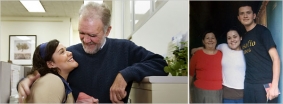
Angela Fillingim with her adoptive father, Jerry Fillingim, Thursday in Berkeley, Calif., and with her birth mother, Blanca Argélica Rodríguez Campos, and her half-brother Henry, 17, in El Salvador last week.
BERKELEY, Calif., Dec. 21 — Last Saturday morning, Angela Fillingim walked through the door of a home in rural El Salvador and met a large group of strangers. It was her family.
Ms. Fillingim, 21, a college senior, was just one of thousands of children who were adopted by couples around the world during El Salvador’s 12-year civil war, which ended in 1992 and left some 75,000 dead. And while she had long hoped her relatives had survived the war, it was not until this month that she had proof, provided by the DNA Reunification Project, a genetic database that helps match children adopted from war zones with their biological families.
Eric Stover, the director of the Human Rights Center at the University of California, Berkeley, which helps oversee the database, said Thursday at a news conference about Ms. Fillingim’s recent reunion that there had been 800 requests from Salvadoran families to find their missing children, some of whom were stolen as war trophies by bands of soldiers.
“Many of those families live in a limbo of hope and despair,” Mr. Stover said. “They don’t know what happened to their children.”
In Ms. Fillingim’s case, her mother, Blanca, a sweatshop worker, gave her up as an infant to protect her from the war as well as from her family’s disapproval of her unwed pregnancy. She was adopted in 1985, at 6 months old, by a married pair of social workers from Berkeley.
Mr. Stover started the project in the early 1990s as part of Physicians for Human Rights, a Boston group, and has since enlisted volunteers from the California Department of Justice to help assemble the database. Working with Pro-Búsqueda, a Salvadoran group that helps reunite war-torn families, the project has led to nearly 200 reunions, Mr. Stover said, though not all have relied on DNA.
Charles Brenner, a forensic mathematician who developed software to help match adoptees to families, estimated that there were about 14,000 adopted Salvadoran children worldwide, with the highest concentrations of families in Europe. While the exact number of children adopted by American families is unclear, Mr. Brenner said it was probably more than 2,000, judging from the number of adoptee visas granted by the State Department during the civil war.
Both he and Mr. Stover said they hoped to use the attention surrounding reunions like Ms. Fillingim’s to raise awareness — and money — for more genetic testing.
“If we can get more of the adoptees in this country and around the world, for that matter, to come forward, we will increase our chances to find the missing families,” Mr. Brenner said. “Conversely, the more we can find hits, the more we can get families in El Salvador to provide DNA.”
Ms. Fillingim’s hopes of meeting her biological family were first raised last year on a trip to El Salvador. During her stay, she heard about Pro-Búsqueda and sought out its office in San Salvador. To her surprise, workers there soon asked her to open her mouth for a DNA swab. There was also something of a paper trail, which helped Pro-Búsqueda narrow the search. The mission was eventually accomplished after another cheek swab — that of Ms. Fillingim’s mother — came back a positive genetic hit.
Ms. Fillingim, a sociology major at the University of California, Davis, got the final results several weeks ago and began planning her trip, though only after finishing graduate school applications.
On her trip, she discovered that her mother and her half-brother Henry, who is 17, live in a small residence in the heavily populated area of Soyapango. “It’s not easy to go back there and to see your family who live basically in poverty, in a pretty bad neighborhood with a lot of gangs,” she said.
There were, of course, happier moments. Her grandmother taught her how to make tortillas, Ms. Fillingim said, though she was not very good at it. And her half-brother sent her off with a note calling her his “little princess” and telling her not to change.
But the most poignant moment was probably the first, Ms. Fillingim said, when her mother saw her and began to cry.
“The first thing I was asked when we met was she asked me to forgive her,” Ms. Fillingim said Thursday, just hours after returning from her trip. “But for me it wasn’t about forgiving her, because I’ve had this great life. I thanked her for making the best decision she could under those circumstances.”
By JESSE McKINLEY
Source: nytimes.com






